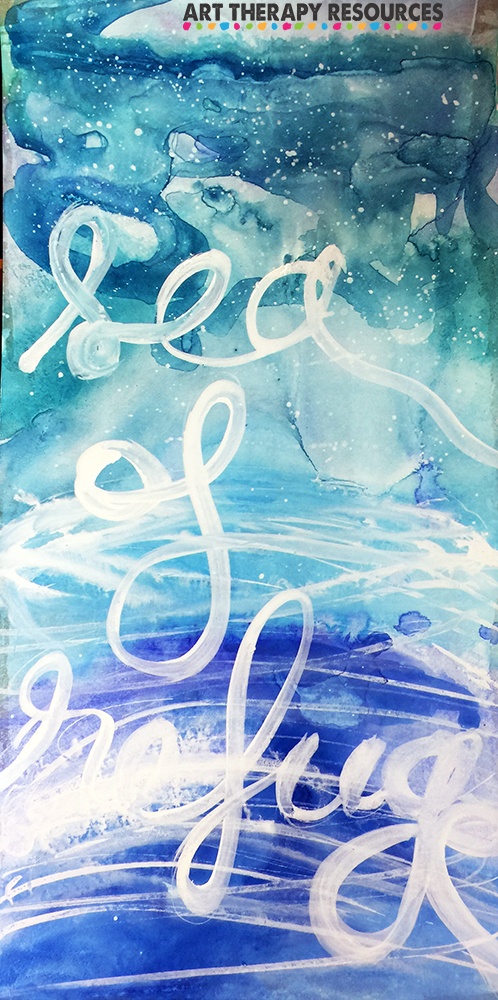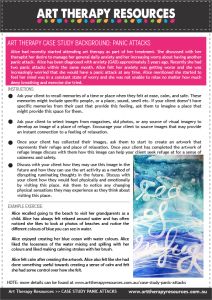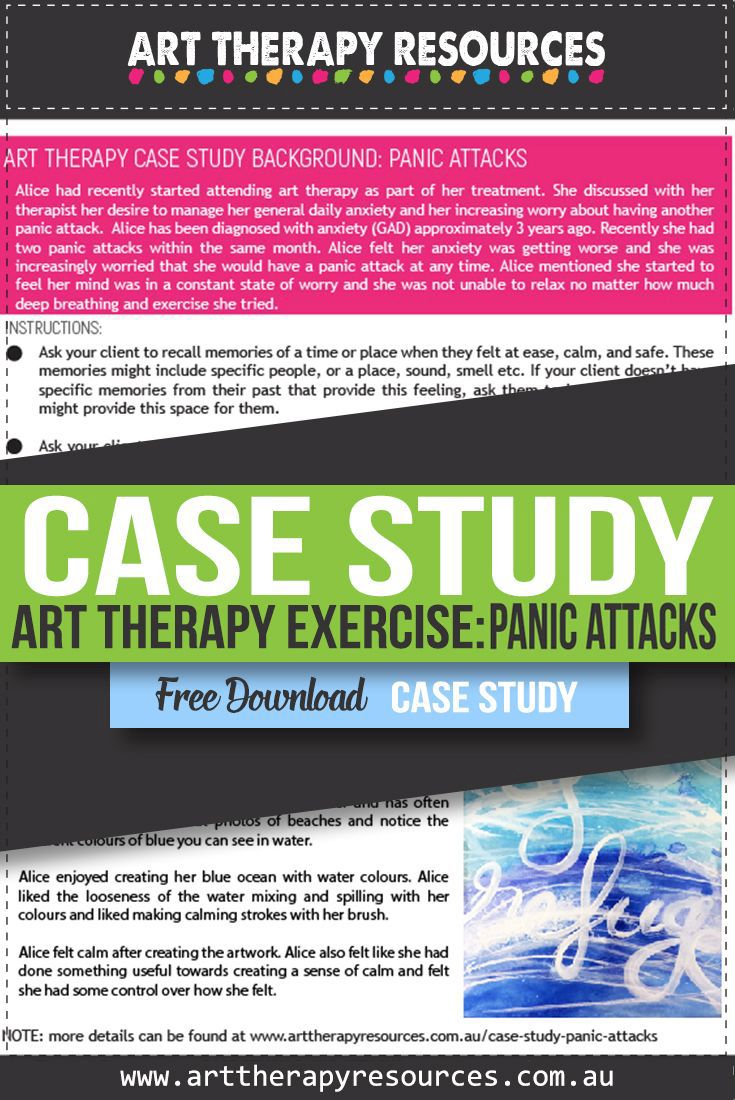THIS POST INCLUDES:
- Art Therapy and Panic Attacks
- About the Client
- Current Client Issues
- Art Therapy Exercise
- Client Insight and Outcomes
- Disclaimer
- FREE DOWNLOAD Art Therapy Exercise
ART THERAPY AND PANIC ATTACKS
A panic attack refers to a sudden occurrence of intense fear that initiates a series of intense physical reactions, even though there is no immediate explainable danger to initiate the triggered feelings. For those who experience panic attacks, the physical symptoms are similar to having a heart attack and can induce thoughts that you are dying.
Some people may experience one or two panic attacks in their lifetime, however, for those who have repeated episodes over time, they can be diagnosed as having a panic disorder. Both panic attacks and panic disorder are qualified as anxiety.
A panic attack can be identified by having four or more of the below symptoms (taken from the DSM-5):
- Palpitations or accelerated heart rate
- Sweating
- Trembling or shaking
- Shortness of breath or sensations of being smothered
- Feelings of choking
- Chest pain
- Nausea or stomach pains
- Feeling dizzy, faint, light headed
- Chills or heat sensations
- Numbness or tingling sensations
- Feeling detached or not within reality
- A fear of losing control or going crazy
- A fear of dying
Given the significant physical symptoms that are connected to panic attacks, it’s important to rule out any medical conditions that may also explain any of the above symptoms.
One of the difficult parts about panic attacks is the looming threat that another one will occur without any warning at any time. This can impact people who have had a previous panic attack as they begin to make decisions about their life that they believe will help reduce the possibility of having a panic attack or reduce the public embarrassment that may occur depending on where the panic attack occurs.
As a consequence people will begin to limit their social outings and reduce their social circle so that they can avoid situations that they believe may induce a panic attack.
HOW ART THERAPY CAN HELP WITH PANIC ATTACKS
One of the primary benefits of art therapy for those who suffer from panic attacks is the ability to calm the nervous system. As individuals become engaged in the creative process they are direct their attention away from escalating negative ruminations.
Art therapy is often used in conjunction with other effective psychological strategies including CBT and mindfulness. These two strategies are used effectively with individuals who experience panic attacks.
Useful techniques such as focused breathing, cognitive reframing, exposure and response prevention, and psychoeducation to address thinking errors can all be used with art therapy to help develop an all-encompassing approach to helping individuals who experience panic attacks.
Art therapy can help people address two important areas of psychotreducation that may assist in understanding and managing panic attacks. This includes what represents as a fear.
There are common fears amongst us all, however, many people carry individual criteria for what they personally fear. Secondly, art therapy can help people address why it is helpful to face fear. This can be a confronting exercise if a person believes that if a fear is manifested, they will experience a panic attack that they can’t control.
WHAT IS FEAR
A fear to each person can be individually derived based on past experiences and beliefs. Fears can be identified within the following domains:
- Specific situations
- Objects
- Health
- Social
- Performance
- Trauma-related
WHY FACE FEAR
Facing fear can provide many benefits to us, however, it’s important to remember that facing fear is not simply a matter of gritting your teeth through an experience. For this reason, there are many avenues that we can explore with clients to help develop coping strategies to face fear and instill a healthy level of resilience to face future fears.
The stages of facing our fears include:
- Expressing the fear in light of beliefs, thoughts, and emotions
- Identifying causes of the fear
- Facing fear through graduated exposure.
These aspects of facing fear are ideally explored through art therapy as the individual can use creative expression at all stages to help translate internal thoughts, physical sensations, and emotions that are relevant to a person.
ADDITIONAL RESOURCES
If you’re looking for additional resources to help supplement this content about chronic illness and art therapy, we sell a number of products in our store that can be used to help clients address the various aspects of coping with a chronic illness. These include:
- Art Therapy Guidebook – Developing Mindfulness
- Art Therapy Guidebook – Developing Motivation
- Art Therapy Guidebook – Developing Resilience
- Art Therapy Guidebook – Developing the Self
- Anxiety Workbook – 6 Week Program
You may also want to read some of our previous blog posts to read more case studies that are related to clients who may have a chronic illness:
- 10 Art Therapy Exercises for Anxiety
- Case Study: Using Art Therapy for a Client with a Stress-related Disorder
- Case Study: Using Art Therapy for a Client with Anxiety (GAD)
- Case Study: Using Art Therapy for a Client with Depression
- Case Study: Using Art Therapy for a Client with Postpartum Depression
- Case Study: Using Art Therapy for a Client with PTSD
ABOUT THE CLIENT
- Name: Alice
- Age: 42
- Summary of sessions to date: Alice had recently started attending art therapy as part of her treatment. She discussed with her therapist her desire to manage her general daily anxiety and her increasing worry about having another panic attack.
CURRENT CLIENT ISSUES
Alice has been diagnosed with anxiety (GAD) approximately 3 years ago. Recently she had two panic attacks within the same month. Alice felt her anxiety was getting worse and she was increasingly worried that she would have a panic attack at any time. Alice mentioned she started to feel her mind was in a constant state of worry and she was not unable to relax no matter how much deep breathing and exercise she tried.
ART THERAPY EXERCISE
This art therapy exercise is designed to give the client a visual representation of a safe space. People can feel overwhelmed with the intangible thoughts and emotions that result from excessively worrying and feeling anxious. This intangible position often leads to more exaggerated thoughts and expectations about the future. This exercise will help introduce a visual image for the client to focus on and use as a tangible representation of seeking calm and reducing anxiety and fear.
INSTRUCTIONS:
- Ask your client to recall memories of a time or place when they felt at ease, calm, and safe. These memories might include specific people, or a place, sound, smell etc. If your client doesn’t have specific memories from their past that provide this feeling, ask them to imagine a place that might provide this space for them.
- Ask your client to select images from magazines, old photos, or any source of visual imagery to develop an image of a place of refuge. Encourage your client to source images that may provide an instant connection to a feeling of relaxation.
- Once your client has collected their images, ask them to start to create an artwork that represents their refuge and place of relaxation. Once your client has completed the artwork of refuge image discuss with them how this image can help your client seek refuge at for a sense of calmness and safety. Discuss with your client how they may use this image in the future and how they can use the art activity as a method of disrupting ruminating thoughts in the future.
- Discuss with your client how they would feel physically and emotionally by visiting this place. Ask them to notice any changing physical sensations they may experience as they think about visiting this place.
CLIENT INSIGHT AND OUTCOMES
Alice recalled going to the beach to visit her grandparents as a child. Alice has always felt relaxed around water and has often noticed she likes to look at photos of beaches and notice the different colours of blue you can see in water. Alice enjoyed creating her blue ocean with water colours.
Alice liked the looseness of the water mixing and spilling with her colours and liked making calming strokes with her brush. Alice felt calm after creating the artwork. Alice also felt like she had done something useful towards creating a sense of calm and felt she had some control over how she felt.

DISCLAIMER
This case study represents a snapshot of the client’s progress in treatment. The exercise in this article could be used as written or as a guide for new and original tasks developed by the Art Therapist. Responsibility for treatment resides with the individual therapist who understands their clients specific needs. The art therapy exercise should not be viewed as a pre-defined directive on how to treat a client that presents with a specific range of problems. This art therapy exercise will help build a database of knowledge to draw upon when helping your client. Art Therapy is associated with psychotherapy techniques, however, each therapist often approaches therapy with their own foundation of psychological interventions, whether it be psychotherapy, CBT, DBT or other methods.
FREE DOWNLOAD: Art Therapy Exercise
Download the FREE Art Therapy Exercise based on the above Case Study. The free download includes instructions for the art therapy exercise, along with an example of the art therapy exercise.

BUILD YOUR ART THERAPY REFERENCE MATERIALS:
Pin this image to your Pinterest board.

SHARE KNOWLEDGE & PASS IT ON:
If you’ve enjoyed this post, please share it on Facebook, Twitter, Pinterest. Thank you!
